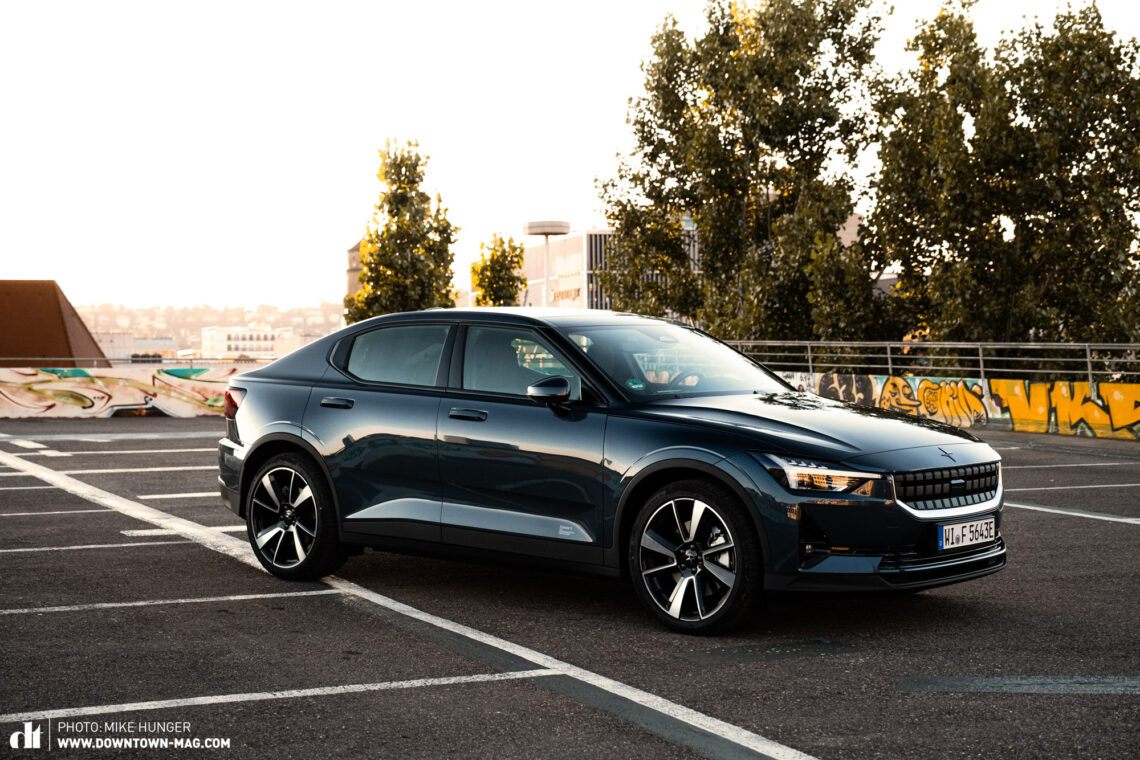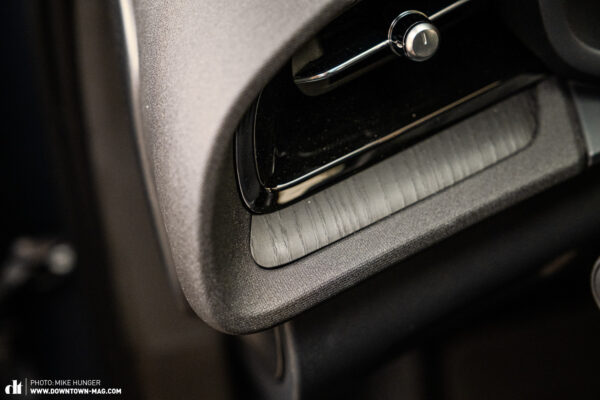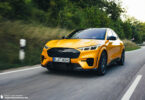At first sight, the Polestar 2 makes an elegant and premium impression. However, can it deliver on this promise upon closer inspection? We’ve put the € 52,725 Polestar 2 with its single motor and 69 kWh battery to the test to find out how much of IKEA is hidden in the high-end Scandinavian EV?
You can find all electric Cars in our big EV special “Which is the best electric car of 2023?“, where you can also check out our personal EV buyer’s guide – free of charge!

There’s a certain allure about Polestar and we were very excited to get our hands on one of their EVs. The brand have managed to make a strong entry into the market, giving themselves a premium image with a big must-have factor. The Polestar 2 is set out to trump the competition with its minimalistic Scandinavian style, and high performance, mixing up the e-mobility market with its (relatively) affordable € 43,725 starting price. Can it meet these expectations, and does it deserve its desirability?
Geely, Volvo, or what? – Who’s behind the Polestar?
Chances are you’ve heard about Polestar, but very few actually know much about the Scandinavian brand, so we thought we’d take the opportunity to fill this gap in knowledge. Polestar originated from the motorsport scene, founded in 1996 and is now a joint venture between motor vehicle manufacturers Volvo and Geely. Polestar functioned as the in-house tuners for Volvo, and they’ve been a standalone electric car brand since 2017. Furthermore, the Swedish brand are blazing a new path with their distribution model – you won’t find any classic dealerships, just Polestar Spaces. While these function as a type of showroom, you can’t buy and drive them home from there. You can configure and order the Chinese made EV from a Polestar Space, via the Polestar app, or website.
Model variants – Why you’re not spoiled for choice with the Polestar 2
Polestar are similarly progressive and innovative as Genesis when it comes to their model variants and configuration, offering hardly any colours, two motors, and two battery options (standard and long-range), as well as two stock packages. That’s it!
The basic version of the Polestar 2 for € 43,725 already comes with LED headlights featuring automatic dimming, 19″ alloy rims, an Android based OS, seat heating up front and keyless entry via your smartphone as standard. That’s more than you get with the basic models of many other brands.
The Polestar 2 on test featuring the single motor and 69 kWh battery comes equipped with the optional Plus and Pilot Lite packages, totalling € 52,725. The € 2,800 Pilot Lite package includes several safety and assist upgrades for the Polestar 2, promising added peace of mind in traffic. For € 4,800, the Plus package includes interior upgrades like a panoramic roof, electric seats with vegan covers, a Harman Kardon sound system, and an inductive charging station for your phone.
When shopping for a Polestar, you’ll look in vain for a configurator the likes of which you’ll find at BMW, Porsche, or Mercedes. The limited customisation helps reduce complexity while keeping the prices and lead times lower. It’s a great concept in theory, since too many choices can get overwhelming and lead to confusion. That said, it’s just in theory because it doesn’t work as well in practice.


New-school in old-school? Look, feel, sound, and interior concept of the Polestar 2
Many EVs are breaking new ground, attempting to establish a new kind of mobility, including the interior look and feel, while others, like the Polestar 2, stick to the tried and trusted ways of combustion engine designs. Thanks to the huge centre console, it gives the impression of a classic fossil-fuel driven vehicle, not dissimilar to our Volvo company car. Other than that, the interior design is imposing yet modest. The door panels and arm rests feature interchanging panels, from textile to artificial wood and dark colours, creating a Scandinavian look & feel.

The electric vehicle sound design and attention to detail are crucial to the value perception, brand promise and emotive aspects, but, unfortunately, this is where Polestar fall short. Look closely and you’ll see uneven gaps between the panels on the dashboard. This doesn’t live up to Polestar’s premium image, reminding us more of the infamous BILLY bookcase series from IKEA. If you use the key to unlock the Polestar, the first thing you’re likely to notice is the cheap-seeming, plastic key, followed by the sound of the central locking mechanism, which sounds like one from an entry level tin can. Fortunately, you have the option of a smaller key, about the size of a USB stick, or the Polestar app on your smartphone as a digital key, both of which come a lot closer to Polestar’s brand aspirations and image. The thin electronic sound emitted by the Polestar 2 when driving slowly or accelerating might be down to Scandinavian understatement, but it lacks charisma and depth, seeming nondescript or even shy. It’s a shame because the right sound can elicit emotions and serve as a very strong form of brand recognition.


Just as the look and feel didn’t always live up to the brand aspirations and promise, so disenchanted were we with the Polestar’s entrance, especially regarding the light design. Our midnight blue test vehicle was a far cry from the cool and sexy entrance it makes in the ads, though it isn’t bad once you adjust your expectations. Depending on the perspective, the headlights either look dynamic or unremarkable, like something off the shelf. We do like the continuous light strip on the rear of the Polestar with its little dance upon unlocking the doors, especially at night. It doesn’t necessarily take a big and curvaceous light design like the taillights of the KIA EV6 to give an electric vehicle that futuristic, spaceship element. But if you’re going to raise expectations as high as Polestar do in their marketing, you’re going to have to deliver instead of disappointing.


A lot of room for luggage in the Polestar 2
The 5-door hatchback-limousine can easily accommodate your weekly shopping with its 405 litre luggage capacity in the rear. Thanks to the divider that can fold away when it’s not needed, you can also secure your cargo and make sure it doesn’t slide forward when you brake. In case you’re on a particularly large shopping spree, you can fold down the rear bench, thereby increasing the luggage capacity to 1,095 litres. Since the hatch opens very widely to the top, you shouldn’t have much trouble loading bulky items either, even letting you chuck in your bike. If you’re in need of still more cargo hauling capacity, the Polestar 2 can be equipped with an optional trailer hitch for € 1,250, which is unusual for an EV and lets you pull up to 1,500 kg. So, you don’t have to wait for the delivery guy when you buy a new couch and can just take it home immediately.



The fun and performance of the Polestar 2 on the road
At first sight, the Polestar 2 makes a sporty impression, but the front-wheel-drive can’t deliver on this promise. When overtaking or accelerating on the highway in dry conditions, the 170 kW motor can transfer its power to the road, but that’s not the case when it’s wet or when putting your foot down as you pull away from a traffic light, in which cases the wheels tend to spin quite easily. The all-wheel-drive, dual motor version would fare significantly better in this regard, allowing you to make the most of the electric motors’ instant power delivery. If this is important to you, we would certainly recommend spending another € 7,700 for the long-range, dual motor upgrade. The Polestar scores for its defined yet comfortable chassis. However, you get a lot of road noise on the inside of the car, especially on slightly rougher asphalt surfaces.
Since the Swedish EV engages regenerative braking the moment you lift your foot off the accelerator pedal, the Polestar 2 can be driven with just one foot using the one-pedal driving technique, recharging the batteries while bringing the car to a halt. The intensity of the regenerative braking can be adjusted in two stages while the additional Creep mode lets the car slowly move forward as soon as you take your foot off the brake, just like in some cars with automatic transmissions. This mode is best suited for parking or driving in stop-and-go traffic. You won’t find any pre-configured driving modes on the Polestar 2 as you might be familiar with from other cars. Instead, the one-pedal driving, crawl mode, and the feel of the steering can be adjusted independently of each other. That isn’t bad, per se, but we’d like to have the option of changing the vehicle’s entire character at the push of a button, avoiding unnecessary steps, and allowing different drivers to quickly and easily adapt the settings to suit their preferences.
If you want something done right, you must do it yourself – The assist functions of the Polestar 2
Not all assist functions are equal, which you’ll soon realise when driving the Polestar 2. Compared to the VW ID.3, the assist functions are very rudimentary and unreliable, serving more as a distraction. The Polestar 2 on test comes equipped with the € 2,800 Pilot Lite optional extra, which includes Adaptive Cruise Control and Lane Keep Assist. While it might sound promising, the functionality is disappointing. The Adaptive Cruise Control recognises speed limit signs, but it doesn’t adjust the speed accordingly and doesn’t hold its speed accurately when going downhill, gradually speeding up, which could get very expensive. Every manager will be familiar with this cliché when delegating tasks: if you want something done right, you must do it yourself.

That said, the system does manage to keep a constant following distance to the vehicle ahead, and the Lane Keep Assist reliably recognises road markings and keeps the car in its lane. It’s only in the dark that it has trouble recognising lanes. On the upside, the collision warning notifies you of traffic from the sides when manoeuvring out of a driveway, which is very helpful when you can’t see what’s coming your way. Combined with the images of the 360° camera displayed on the large touch screen, you’re provided with plenty of visibility.

The portrait format touch display integrated into the centre console runs on the Android operating system. Like on your phone, it gives you access to the Google Play store and is compatible with most of the apps. Polestar rely on Google Maps instead of in-house navigation software, which works excellently – if you’ve got network coverage, that is. It identifies traffic jams early enough to avoid them and inputting your desired destination is easy via voice command. If you haven’t got network coverage, however, the navigation system doesn’t work, and the well-meaning tips it displays to ask someone for directions, call a friend or listen to music aren’t much help in instances like that. Another gripe is that Apple users can only use CarPlay with a cable… In our digital, all-wireless age that seems very old-school.



Polestar 2 – Range, charging, and charging speed
To help keep your eyes on the road, you have the option of displaying the navigation screen on the speedometer instead of just the large centre console. In case the desired destination is out of range, based on the current state of charge, you get notified that you’ll need to charge the batteries. However, the navigation system will only integrate the charging stations into your route when prompted. At least the Polestar 2 then calculates the ETA based on the required charging time. As with Google Maps, clicking on the various charging stations gives you further information about their status, charging power and payment options.
Once you arrive at the charging station, the charging cable is neatly stored in the frunk (front trunk), where it’s quickly and easily accessible even when you’re hauling a ton of luggage. Another advantage of the separate storage compartment for the charging cable is that it won’t get your luggage dirty. According to the manufacturer, the Polestar 2 can be charged at a power of up to 150 kW from fast chargers, but that’s just the peak and when the battery is almost empty. The highest charging power we could achieve with an outside temperature of around 25 to 30°C was a little over 100 kW. From approximately 50% capacity, it dropped to about 70 kW, which is relatively low for fast charging. You must also keep in mind that an electric car’s charging power and range generally drops at colder temperatures. The Polestar 2 on test features a 69 kWh capacity battery, which is claimed to provide a WLTP range of 474 km. During our test drives, covering around 1,200 km – on highways, in the countryside, and the city – our average consumption settled at 20.4 kWh per 100 km.
The Polestar 2 on test – Marketing vs. reality
We must admit, we had high expectations of the Polestar 2, but we were disappointed in the end. Due to the marketing, the Polestar 2 has got a progressive image, when, in reality, it seems conservative and not nearly as premium as it makes out to be at first glance. The fact that the interior design leans so heavily on the layout of classic combustion models is a matter of taste. Not so with many of the other details like the sound design and finishing quality, which just don’t live up to the Scandinavian brand’s premium aspirations. It’s all somewhat reminiscent of IKEA, as both companies unfortunately, cut corners in places that aren’t immediately evident. Both the Polestar’s charging speed and the assist functions aren’t satisfactory. Instead of the assisting, some of the helpers end up being more a distraction. Worst of all, you must fork out an additional € 2,800 for these functions and end up having to do a whole lot of the driving yourself anyway. There are significantly better systems on the market, capable of reliably and smartly taking the stress out of driving.

Holy Swede! The Polestar 2 wants to shape the future, but it can’t keep up with current standards. The optionally available assist functions, the finishing details, the sound design, and the charging speed aren’t up to scratch. That said, if you want an elegant-seeming, compact limousine featuring a classic design with twists like the continuous light strip at the rear, it could be just what you’re looking for. We’d recommend going for the dual motor option for more performance and fun in the Polestar 2.
Tops
- classic interior layout
- dedicated front storage compartment for the charging cable
- Google Maps navigation – if there’s network coverage
- tow hitch optiontaillight design
Flops
- doesn’t live up to its premium image and marketing promise
- Google Maps navigation is useless without network coverage
- low charging power
- en route charging stations only indicated when prompted
- unreliable and imprecise assist functions
- Apple CarPlay only works with a wired connection
- Front-wheel-drive = less fun and sporty handling
Configuration tip: long-range, dual motor
All tested e-cars: City Transformer Prototyp | Fiat 500e | Honda e | KIA EV6 | Opel Rocks E | Polestar 2 | Porsche Taycan | Smart EQ Forfour | Tesla Model 3 Dual Motor Long Range | VW ID.3 | VW ID.BUZZ
Words: Mike Hunger Photos: Mike Hunger, Robin Schmitt







